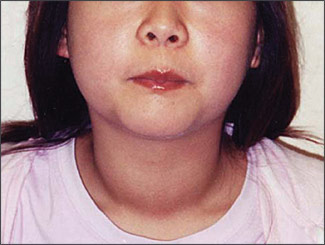
Am Fam Physician. 2006;73(10):1793-1794
A 14-year-old girl presented with a two-week history of polyphagia, puffy eyes, palpitations, heat intolerance, nervousness, loose stools, and fatigue. She also complained of decreased concentration over several months at school. She denied experiencing weight loss or insomnia. Developmentally, she had thelarche at 10 years of age and menarche at 11 years of age, and her menstrual periods were regular. Her paternal grandmother had a goiter, but the family was unable to remember whether she had hypo- or hyperthyroidism.
On examination, the patient's heart rate was 120 beats per minute, her respiratory rate was 30 breaths per minute, and her blood pressure was 120/68 mm Hg. She had mild exophthalmos, lid lag, and a fine hand tremor. The thyroid gland was diffusely enlarged and nontender (see accompanying figure). Her skin was very warm and moist, and her face was flushed. Results of the rest of the examination were normal. Laboratory investigations showed a thyroid-stimulating hormone (TSH) level of less than 0.01 mU per L (0.01 U per L), a free thyroxine (T4) level of 12 ng per dL (155 pmol per L), and markedly elevated levels of antithyroid peroxidase and TSH-receptor antibodies.

Question
Discussion
The answer is C: Graves' disease. Graves' disease is an autoimmune disease characterized by the presence of antibodies directed against thyroid antigens such as the TSH receptor, thyroglobulin, and thyroid peroxidase. This results in excessive thyroid hormone production, leading to accelerated metabolism. Graves' disease most often affects adult women; when it occurs in youth, however, it usually happens during adolescence. Girls are affected five times more often than boys.1
The onset usually is insidious. Classic symptoms include heat intolerance, fatigability, weight loss (despite adequate or increased appetite), nervousness, palpitations, insomnia, oligomenorrhea, and increased frequency of bowel movements. Impaired attention span, behavioral problems, and deterioration in school performance are common.2 Physical examination signs include diffuse thyromegaly (often with a bruit), tachycardia, wide pulse pressure, excessive perspiration, rapid tendon reflex relaxation phase, tremor, exophthalmos, lid lag, and lid retraction. Height for age and bone age may be advanced.3 Pretibial myxedema and periodic paralysis may occur.4
Subacute granulomatous thyroiditis (de Quervain's thyroiditis) presents with painful, diffuse enlargement of the thyroid gland associated with symptoms and signs of hyperthyroidism. It is usually viral in origin. The free T4 level is elevated, and TSH is suppressed. Unlike in Graves' disease, a radioactive iodine scan shows a low uptake. The hyperthyroidism is self-limited and usually lasts for one to two months. It can be followed by transient hypothyroidism.
Acute suppurative thyroiditis is bacterial in origin and often related to a pear-shaped sinus fistula or thyroglossal duct remnant. The condition often presents with fever, sore throat, local erythema, and painful mass in one thyroid gland lobe (usually the left side).5 Leukocytosis usually is present, and thyroid function test results are normal.5
Toxic adenoma presents as a thyroid nodule with biochemical evidence of hyperthyroidism. Lack of ocular changes helps differentiate toxic adenoma from Graves' disease.6 Although many patients show elevation of T4 and triiodothyronine (T3) levels, preferential elevation of T3 (T3 toxicosis) often occurs.7
Chronic lymphocytic thyroiditis (Hashimoto's disease) is the most common cause of acquired hypothyroidism in childhood and adolescence. Physical examination usually reveals a diffusely enlarged, firm, nontender gland. Most of the affected children are euthyroid or hypothyroid. When affected children have hypothyroidism, they may have growth retardation, cold intolerance, lethargy, constipation, bradycardia, coarse and dry skin, myxedema, and brittle hair.
| Condition | Characteristics |
|---|---|
| Graves' disease | Diffuse thyroid gland enlargement; hypermetabolism; elevated free T4 level, low TSH level, elevated thyroid autoantibody level; increased radioactive iodine uptake |
| Subacute granulomatous thyroiditis (de Quervain's thyroiditis) | Painful enlargement of the thyroid gland; hypermetabolism; elevated free T4 level, low TSH level; decreased radioactive iodine uptake |
| Acute suppurative thyroiditis | Fever, painful mass in one thyroid gland lobe; normal thyroid function tests and radioactive iodine uptake |
| Toxic adenoma | Solitary thyroid nodule; hypermetabolism; lack of ocular changes; elevated free T4 level, low TSH level |
| Chronic lymphocytic thyroiditis (Hashimoto's disease) | Diffuse enlargement of the thyroid gland with or without clinical features of hypometabolism; normal thyroid function tests or low free T4 level, elevated thyroid autoantibody level |